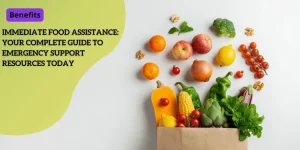Senior Food Assistance Programs Explained: From Eligibility to Application

Anúncios
Importance of Proper Nutrition for Seniors’ Health and Independence
Proper nutrition for seniors is crucial for maintaining both health and independence.
Nutritional support isn’t just about reducing hunger; it impacts an individual’s overall well-being.
Anúncios
Balanced diets can prevent chronic diseases, support cognitive function, and improve emotional stability.
For older adults, maintaining a healthy diet is key to preserving mobility, which directly affects their independence and quality of life.
Anúncios
To help seniors achieve these nutritional goals, food assistance programs play a vital role.
They provide access to essential nutrients, which might otherwise be unaffordable or inaccessible due to financial constraints.
By supporting dietary needs, these programs enhance seniors’ ability to live independently and enjoy a higher quality of life.
Overview of Available Nutrition Assistance Programs
Several food assistance programs are specifically designed to support seniors aged 60 and older.
These programs provide different forms of aid to ensure seniors have access to nutritious food:
- Senior Farmers’ Market Nutrition Program (SFMNP): This program offers coupons that seniors can exchange for fresh, locally-grown produce at farmers’ markets, roadside stands, and community farms. It promotes not only healthy eating but also community engagement.
- Commodity Supplemental Food Program (CSFP): Administered by the USDA, this program supplies monthly packages of nutritious food to low-income seniors. The food items are distributed through local agencies to ensure widespread access.
- Supplemental Nutrition Assistance Program (SNAP): While not exclusively for seniors, SNAP supports low-income individuals and families in purchasing healthy food through an EBT card at various grocery and food retailers.
Each program offers a unique approach to nutritional support, allowing seniors to choose the options that best meet their needs and circumstances.
Basic Eligibility Requirements (Age 60+ and Income Thresholds)
Understanding the eligibility criteria is the first step toward accessing these food assistance resources.
Generally, seniors must meet the following conditions:
- Age: Seniors must be at least 60 years old to qualify for most senior food assistance programs.
- Income: Households must have an income at or below 185% of the federal poverty level (FPL). This threshold ensures that the resources are directed to those who need them the most.
To confirm eligibility, applicants typically need to provide documentation such as proof of age, income statements, and residency verification. These criteria and requirements help streamline the process and ensure that aid reaches the intended recipients.
As seniors navigate these programs, understanding these basics sets the foundation for effectively utilizing available resources and improving their nutrition and overall well-being.
Maintaining awareness of the specific requirements and benefits of these programs enables seniors and their caregivers to make informed decisions, thereby enhancing health outcomes and fostering independence.
Senior Farmers’ Market Nutrition Program (SFMNP)
Program Benefits
The Senior Farmers’ Market Nutrition Program (SFMNP) brings an abundance of healthful goodies to seniors aged 60 and above.
Participants receive coupons that can be exchanged for locally grown fresh fruits, vegetables, honey, and herbs.
This initiative helps improve their nutritional intake and encourages support for local farmers and small-scale producers.
The focus on fresh, seasonal produce ensures that seniors enjoy a diversified and nutrient-rich diet. Ultimately, this enhances their overall well-being and promotes healthier living.
Accepted Locations
One of the strengths of the SFMNP is the flexibility it offers in terms of where the coupons can be redeemed.
Seniors can use these coupons at various locations:
- Farmers’ markets
- Roadside stands
- Community farms
By offering multiple redemption points, the program ensures it caters to diverse geographic areas and meets the varying accessibility needs of senior participants.
This wide range of options makes it easier for seniors to access fresh produce within their local communities.
Promoting Healthy Eating Habits
The SFMNP goes beyond providing financial aid; it promotes long-term healthy eating habits among seniors.
Access to fresh, locally grown produce encourages seniors to adopt healthier dietary patterns, leading to numerous health benefits like improved digestion, better immune function, and reduced risk of chronic diseases.
Additionally, the interaction with local food systems and communities fosters social engagement, reducing feelings of isolation and promoting mental well-being.
Such holistic benefits make the SFMNP a win-win situation for both seniors and local agriculture, emphasizing the importance of community-supported nutrition.
By enhancing seniors’ access to fresh produce and fostering a connection with local food sources, the SFMNP significantly contributes to improving the quality of life for many older adults.
Up next, we explore another valuable program that provides essential nutritious food packages on a monthly basis.
Commodity Supplemental Food Program (CSFP)
Monthly Nutritious Food Packages Provided by USDA
The Commodity Supplemental Food Program (CSFP) offers essential support to low-income seniors by providing them with monthly packages of nutritious food.
Coordinated by the USDA, these food packages aim to supplement the diets of seniors aged 60 and older, ensuring they receive the nutrients necessary for a healthy and active lifestyle.
Each package includes a variety of essential items such as fruits, vegetables, proteins, cereals, and dairy products, which help in reducing the risk of chronic diseases among older adults.
Local Distribution System and Pickup Locations
One notable feature of CSFP is its efficient local distribution system.
The USDA sends food items to local agencies, which are responsible for organizing the distribution to eligible seniors.
These agencies can include:
- Food banks
- Senior centers
- Non-profit organizations
This setup makes it convenient for participants to pick up their food packages from accessible locations within their communities.
They ensure the senior community can easily access the food supplies they need without significant travel or inconvenience.
Possibility of Food Delivery Services in Certain States
While the majority of seniors pick up their food packages from designated locations, certain states offer food delivery services to cater to those who face mobility challenges or transportation issues.
This option is particularly beneficial for seniors who find it difficult to leave their homes, ensuring they receive their monthly food supply without added stress or difficulty.
By accommodating varying needs, CSFP strives to enhance food accessibility for all eligible seniors regardless of their physical capabilities.
With these well-structured methods, CSFP ensures that low-income seniors have reliable access to the nutritious food they need to maintain a healthy lifestyle.
Understanding these systems highlights the support available to seniors through this valuable program.
Eligibility Requirements and Documentation
Ensuring accurate eligibility requirements for food assistance programs is crucial, as it determines who receives support.
Generally, the following basic criteria must be met:
Age Requirement
To qualify for senior food assistance programs such as the Senior Farmers’ Market Nutrition Program (SFMNP) and the Commodity Supplemental Food Program (CSFP), you must be at least 60 years old.
These programs specifically target older adults to guarantee they have access to nutritious food.
Income Threshold
Your household income must also be at or below 185% of the federal poverty level.
This threshold ensures that benefits reach those who are genuinely in need.
For many seniors living on a fixed income, meeting these guidelines is vital to qualify and receive support.
Required Documentation
To verify eligibility, providing the following documentation is essential:
- Proof of Identity: Acceptable forms include a valid ID card or birth certificate.
- Proof of Income: Recent pay stubs, Social Security benefits statement, or a recent tax return are usually required.
- Proof of Residency: Utility bills, lease agreements, or property tax receipts are generally acceptable forms.
These documents help confirm necessary details such as age, income, and residency to ensure that the assistance reaches the right individuals.
Accurate eligibility determination not only ensures that food assistance programs run smoothly but also guarantees that they serve the seniors who need them the most.
Now that you understand the eligibility requirements and necessary documentation, the next step involves navigating the application process to secure these vital benefits.
Application Process
Steps to Apply for Food Assistance Programs
Navigating the application process for senior food assistance programs doesn’t have to be overwhelming.
Here’s a step-by-step guide to help you get started:
- Check Eligibility: Make sure you meet the basic eligibility requirements, such as being at least 60 years old and having a household income at or below 185% of the federal poverty level.
- Find Local Programs: Identify food assistance programs available in your area. Contact your local Area Agency on Aging, visit official senior assistance websites, or check with local government offices.
- Gather Required Documents: Collect the necessary paperwork to prove age, income, and residency. Common documents include:
- Proof of age: birth certificate or state ID.
- Proof of income: Social Security statements, pension documents, or recent tax returns.
- Proof of residency: utility bills, lease agreements, or property tax receipts.
- Complete the Application: Fill out the specific application forms for the programs you’re interested in. These forms are usually available online on state health and human services websites or at local government offices.
- Submit the Application: Submit your completed application along with all required documents. You can typically do this online, by mail, or in person depending on the program’s guidelines.
Verification Process and Potential Interviews
Once your application is submitted, the verification process ensures that all your information is accurate and meets the eligibility criteria.
This may include:
- Reviewing your submitted documents to confirm your eligibility.
- Some programs might require an interview, either in person or over the phone, to further verify your details.
These steps are crucial for ensuring that assistance goes to those who truly need it.
Contacting Local Administering Agencies for Support
For additional support during the application process, reaching out to local administering agencies can be incredibly helpful.
These agencies provide invaluable assistance, such as:
- Offering information about available programs.
- Helping gather and organize your required documents.
- Guiding you through the application process step-by-step.
To find a local agency, you can:
- Visit the National Council on Aging website and use their resource locator.
- Contact the Eldercare Locator at 1-800-677-1116 for personalized assistance.
- Visit your local government offices dedicated to senior services.
By following these steps and making use of these resources, you’ll be better equipped to access the nutrition assistance you need.
Understanding this process ensures timely and effective support for your nutritional needs and enhances your overall quality of life.
Alternative Programs and Resources
SNAP Benefits as an Alternative Option
When SFMNP or CSFP programs are unavailable, the Supplemental Nutrition Assistance Program (SNAP) can be a valuable alternative for seniors.
SNAP helps low-income individuals and families purchase essential food items to maintain good health.
Benefits are provided on an EBT card, which functions like a debit card and can be used at most grocery stores, supermarkets, and some farmers’ markets.
To apply for SNAP:
- Visit your local SNAP office or apply online through your state’s website.
- Provide proof of identity, residency, income, and expenses.
- Complete an interview process, which may occur in person or over the phone.
Local Food Banks and Community Resources
Beyond federal programs, many local resources are available to assist seniors in need of food.
Community food banks, church pantries, and local charitable organizations often run food distribution programs specifically tailored to seniors.
These resources can provide emergency food supplies and ongoing support to those who qualify.
In areas where visiting these locations may be challenging for seniors, some community programs offer home delivery services.
This option is particularly beneficial for seniors with mobility issues or health problems, ensuring they receive the food they need without added stress.
Combining Different Programs for Maximum Benefit
To maximize nutritional support, seniors can combine various food assistance programs.
For example, eligible beneficiaries can receive SNAP benefits while also utilizing resources from local food banks and community programs.
By leveraging multiple programs, seniors can ensure a more balanced and varied diet, which improves overall health and well-being.
It’s essential to stay informed about the food assistance options available in your community and to utilize multiple resources when needed.
Each program offers unique benefits that collectively contribute to better nutrition and food security for seniors.
To navigate these options effectively, always reach out to local administering agencies for guidance and support.






